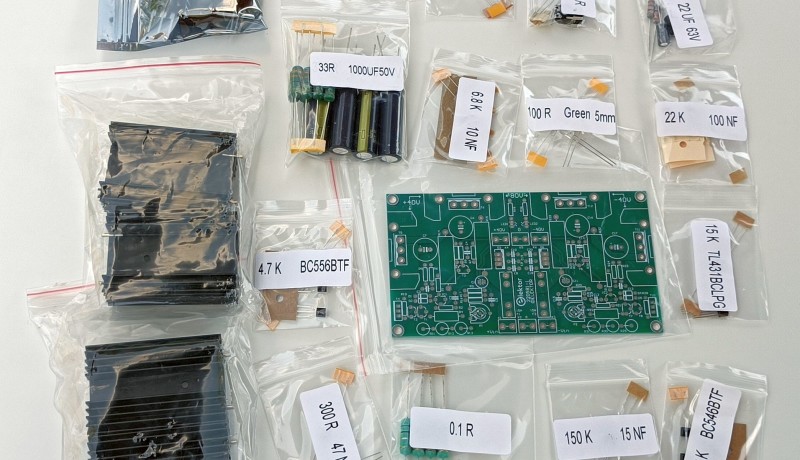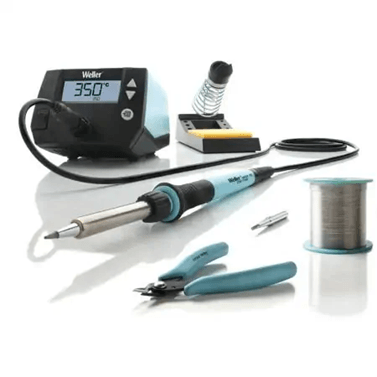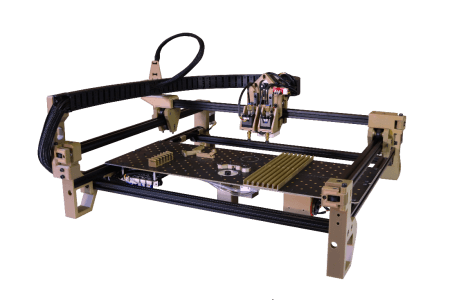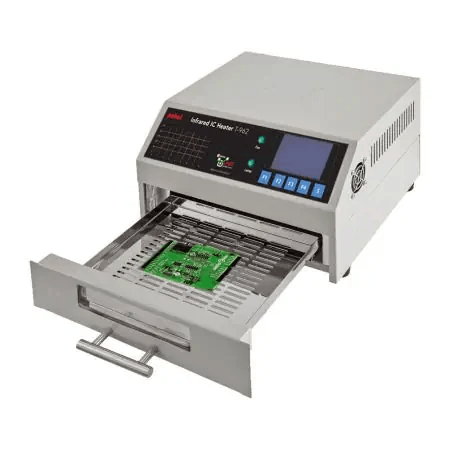Low-Volume PCB Production: 7 Tips for Better PCB Design
on

Do you have an innovative design that you want to produce in small quantities? Before you begin PCB production, consider all of your options, from DIY assembly to five-star services. Let's take a look at the possibilities, plus seven tips for better PCB design.
So, you have designed and tested an electronic circuit board, and now you want to produce it in (small) quantities. However, if you don’t have the financial clout to just order 10,000 pre-assembled boards and store them somewhere from where you can sell them at leisure, what are your options?
The first option that comes to mind is assembling the boards yourself. This is very possible when the quantities are small, and the board doesn’t have too many components (Figure 1). Now, this may sound simple, but there are a few things to think of before you start.

Start by choosing a board-manufacturing house. This can be a pooling service if you only need a few boards. But if you need (several) hundreds, then it will be more advantageous to compare quotes from different non-pooling manufacturers.
Author's note about PCB production and "Pooling": PCBs are manufactured in a so-called production panel. The same production panel can generate circuit boards for various customers with the same specs. We refer to this collection of related orders as pooling. Pooling promotes flexibility and lowers manufacturing costs.
Source the Components
If you carried out the board design process in the correct order, you already have a component list or bill of materials (BoM) with, for each line, a complete manufacturer reference and an address of a company where you can buy the part. Having a one-stop shop for the entire BoM would be ideal, but, in most cases, this shop does not exist. Various suppliers are required to source all the components, and each supplier will charge shipping and handling. Therefore, clever shopping will save you money. At the same time, it will cost you time, so balancing the two is important.
Assemble the Board
Once you have the PCBs and the components, it’s time to assemble the boards. Do you have the tools required for this? A small soldering iron (Figure 2) may be fine for putting a prototype together, but is it comfortable enough for assembling twenty, fifty, or a hundred boards? And the parts — are they through-hole only, SMT only, or is it a mix? Usually, you want to avoid mixing mounting technologies because it complicates board assembly. All SMT is nice because the board can be soldered in an oven. However, placing such parts on the board is a delicate job. And, as solder paste is needed for this, did you order a stencil to apply it properly? How are you going to align the stencil on tens of boards? This will be easier when the PCBs are in a panel.

Testing
After assembling the boards, they must be tested. For this, you will need suitable equipment. Building a test rig, or a programmer, or even both, may be a good idea.
Selling and Shipping
If you’ve ever sold something on a site such as eBay, you’ll know that selling something is more complicated than just finding a buyer for the product. Selling also includes invoicing, packing and packaging, and shipping, and these things all cost time and money.
PCB Prodction: What Are the Options?
As a matter of fact, the problems mentioned above must be solved for any production method you may choose, from one piece to mass production. And, since board manufacturing is a complex process, there exist many companies that offer services to make things easier for you. Of course, everything has a price, so it’s up to you to find the right compromise between cost, time, and peace of mind.
PCBA Pooling
Some PCB manufacturers propose a board assembly service. They are so-called PCBA houses, where the “A” means “assembly.” So, instead of ordering a bare PCB from them, you can order a fully assembled board. That sounds convenient, right? It is convenient, but not only does it come at a cost, it also makes component sourcing a bit complicated. You have your BoM, and they have their inventory, and the two will not match on every line, and maybe not even on a single line. Therefore, you must carefully check every part on your component list against the parts that the assembly house suggests. This is a time-consuming task. And, of course, not every part will be in stock or even available, making costs and delays unsure. You can adapt your circuit design beforehand to the assembly service’s component stock to make this step easier.

Most PCB pooling services also provide assembly services (Figure 3) along with component sourcing for you, which can be very helpful in reducing the hectic task of finding and then soldering the components; soldering a few PCBs can be fun, but more than a few can be tedious.
Just like ordering a PCB, ordering assembly is almost similar, but some additional details are required by the manufacturer, such as number of unique components, number of SMD and through-hole parts, and so on (Figure 4). It’s good practice to add this information to the BoM and mention the types of components next to their name. This avoids any mistake by the manufacturer and saves time while fulfilling the order.

The manufacturer will provide you with a quote for the assembly service after you provide information about the component types and quantities, etc. This quote does not include the cost of components. After you submit your order, the manufacturer’s support team will get involved and inform you of whether the components and their references in the BoM match with your PCB or not. They will then provide you with a quote for the components.
To save money on components, it’s necessary to carefully review the price of the components and compare them to other sources such as Mouser, DigiKey, and AliBaba (Figure 5). It’s reasonable to proceed with them if the components are at a fair price and the correct components are offered by the manufacturer. Usually, some components are not available, and some are priced above the normal cost. In this case, it is preferable to obtain the components from AliBaba resellers, as they typically offer a much lower price than the PCB pooling service (and that can often be further reduced by negotiating with the reseller). It’s best to initiate conversations with three or more resellers before settling on one that’s verified and has a better offer.

After settling with one of the resellers, components are to be sent to the PCB pooling service. Therefore, make sure the address of the PCB manufacturer is properly printed on the parcel. Ask the reseller to share a picture of the parcel showing the address and the tracking number. This ensures that everything’s in order and that the shipment can be tracked. It’s a good idea to share the tracking number and picture of the parcel with the pooling service’s support team. This avoids any delays in order processing. A smooth assembly process is ensured by effective communication with both manufacturer and component reseller.
PCB Production: Five-Star Services
On the other hand, there exist companies that take your BoM and buy all the parts for you. Because they have many clients, they can buy in larger volumes than you, which lowers the price of the BoM. These companies can also order the PCB for you, removing another task from your list. They can also assemble the boards for you, and they can program and test the boards for you. Some will even stock and ship the boards for you. But, as usual, these services come at a cost. Even though super convenient, there is a catch: Many of these companies only accept orders starting at, say, one hundred or more boards, which may be just too many for what you had in mind. And, they may only accept professional customers, which means that you must start a company first.
DIY Assembly?
Assembling the circuit boards yourself can be the cheapest solution, if you do not count the hours you’ll have to put in. Especially for SMD boards, all sorts of low-cost assembly tools have seen the light of day, from small pick-and-place machines, solder paste printers to reflow ovens and hot plates. For a few thousand euros, you are up and running. But, is it worth such an investment when you only have a hundred boards to do? Or, are you counting on follow-up orders? If not, just a soldering iron is the way to go. If you do, at least buy a solder fume extractor.

One of the options for having your SMD assembly setup is LumenPnP from Opulo (Figure 6). It’s an open-source, easy-to-install, cost-effective pick-and-place machine that, most importantly, does not require too much space in your workspace. This makes it a good choice for makers and hobbyists. Other open-source options include OpenPnP and SimplePnP, etc.

Getting and using these PnP solutions is not the end of the story, but instead opens a whole new chapter. You will need a complete setup and process flow, including solder paste stencil handling (Figure 7), a PCB pre-heater (Figure 8), a reflow oven (Figure 9) and a board-testing setup. This sounds nice, but please note that these tools must be set up and configured for your board. You will have to do test runs to make sure the configuration and settings are imported correctly from your PCB design. Then, add the components to the feeders and monitor the process to check that the machine is running properly, does not run out of components, and puts the components in the correct places. This can reduce the workload as compared to soldering manually, but it can also be tedious because it requires continuous monitoring if you would rather not be disappointed after returning from a coffee break. Overall, it’s a nice setup to have, but if you don’t want to go down this path, you always have the option of PCBA services available.



Regardless what option you choose, the sight of a fully assembled PCB (Figure 10) is always satisfying!
7 Tips for Better PCB Production and Design
When aiming for cost-effective PCB designs, paying attention to specific technical details and industry standards can greatly optimize your approach. Here are some valuable tips and tricks to consider:- Track Width and Gap: Follow the IPC-2221 standard for guidelines on track width and the desired current carrying capacity. For gap (clearance) between traces, pads, or components, maintain a minimum distance of 0.2 mm for low-voltage designs (<50 V) in a standard environment.
- Manufacturing Tolerances: Ensure that your design adheres to manufacturing tolerances specified by the manufacturer. Confirm that dimensions, spacing, and hole sizes for components and vias are within acceptable limits to avoid fabrication issues.
- Impedance Control: For high-frequency designs or applications requiring controlled impedance, calculate the trace width and separation based on desired characteristic impedance, substrate dielectric constant, and copper thickness. Use online calculators or specialized software tools to determine accurate trace dimensions.
- Solder Mask and Silkscreen Alignment: Pay attention to proper alignment between the solder mask and silkscreen layers. Ensure the design accounts for the required alignment tolerance specified by the manufacturer to maintain visual appearance and manufacturability.
- Panelization: Optimize low-volume production by panelizing multiple PCBs on a single panel. Follow manufacturer guidelines for panelization to ensure efficient manufacturing and cost reduction.
- Component Footprints: Use standardized component footprints to ensure compatibility and reduce manufacturing costs. Verify that the footprints match the specific components you intend to use, referring to industry-standard libraries or component manufacturer recommendations for accuracy.
- Testability: Design the PCB with testability in mind to reduce testing and debugging costs. Incorporate test points, probe access areas, and built-in self-test (BIST) capabilities where applicable. This enables efficient testing during manufacturing, minimizing the need for costly rework or troubleshooting.
Comparison of Various PCB Services
- Beta Layout: Stands out for its comprehensive PCB service portfolio. They provide options for PCB manufacturing, assembly, and even 3D printing. Beta Layout offers fast and reliable production, with a wide range of materials and finishes available. Their user-friendly website features an online Gerber viewer, making it easy to review and verify designs. Additionally, Beta Layout offers a Design Rule Check (DRC) tool to assist with design validation.
- Eurocircuits: Known for its high-quality PCB manufacturing and assembly services. They offer a wide range of PCB options, including prototype and production runs. It also provides a user-friendly online platform with instant pricing and a quick turnaround time. Their strong focus on customer support and extensive design rule checks ensure optimal results. Eurocircuits also offers a visualizer tool that allows users to review their PCB design before manufacturing.
- JLCPCB: Known for its competitive pricing and high-quality manufacturing. They offer a wide range of PCB options, including quick-turn prototypes and larger production runs. JLCPCB provides an easy-to-use online ordering platform and supports multiple file formats. Their extensive quality control processes, such as automated optical inspection (AOI), ensure reliable PCB fabrication.
- OSH Park: A community-focused PCB service known for its distinctive, purple-colored boards. They specialize in prototype PCB manufacturing, providing high-quality results with attention to detail. OSH Park has a user-friendly website where users can upload their designs and review a visual rendering of the fabricated PCB. They prioritize transparency and offer shared projects for community feedback.
- PCBWay: A popular choice for low-volume PCB manufacturing due to its affordability and fast turnaround times. They offer a streamlined online ordering process, with real-time price calculation and instant quoting. PCBWay supports a variety of PCB options, including flexible and rigid-flex boards. Their website also provides an online Gerber viewer and a design rule check feature to ensure design accuracy.
PCB Production: Summary and Recommendations
Choosing the right PCB pooling service depends on specific project requirements, budget, and desired features. According to the comparison between the forementioned pooling services, PCBWay is the cheapest of the bunch if ordering 10 or fewer PCBs, but more than that, every other service costs almost the same. JLCPCB comes second in terms of pricing, typically, these services are also running a quite convenient offer. Consider factors such as pricing, manufacturing capabilities, turnaround time, quality control measures, and customer support. It’s also beneficial to review user feedback and ratings for each service.
This article (230477) appears in Elektor November/December 2023. Questions about this article or PCB production? Contact Elektor's editorial team today.



Discussion (2 comments)